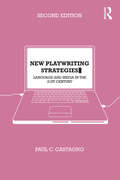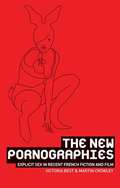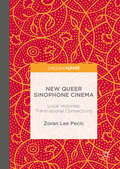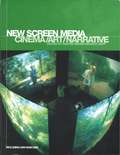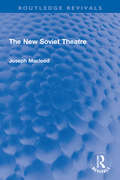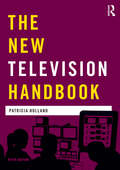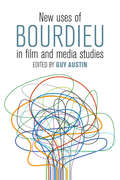- Table View
- List View
New Playwriting Strategies: Language and Media in the 21st Century
by Paul C. CastagnoNew Playwriting Strategies has become a canonical text in the study and teaching of playwriting, offering a fresh and dynamic insight into the subject. This thoroughly revised and expanded second edition explores and highlights the wide spread of new techniques that form contemporary theatre writing, as well as their influence on other dramatic forms. Paul Castagno builds on the innovative plays of Len Jenkin, Mac Wellman, and the theories of Mikhail Bakhtin to investigate groundbreaking new techniques from a broad range of contemporary dramatists, including Sarah Ruhl, Suzan Lori-Parks and Young Jean Lee. New features in this edition include an in-depth study of the adaptation of classical texts in contemporary playwright and the utilizing new technologies, such as YouTube, Wikipedia and blogs to create alternative dramatic forms. The author’s step-by-step approach offers the reader new models for: narrative dialogue character monologue hybrid plays This is a working text for playwrights, presenting a range of illuminating new exercises suitable for everyone from the workshop student to the established writer. New Playwriting Strategies is an essential resource for anyone studying and writing drama today.
The new pornographies: Explicit sex in recent French fiction and film
by Martin Crowley Victoria BestThe turn of the twenty-first century has witnessed the striking advance of pornography into the Western cultural mainstream. Symptomatic of this development has been the use by writers, artists, and film-makers of the imagery and aesthetics of pornography, in works which have, often on this basis, achieved considerable international success. Amongst these artists are a number of French authors and directors - such as Michel Houellebecq, Catherine Breillat, Virginie Despentes, or Catherine Millet - whose work has often been dismissed as trashy or exploitative, but whose use of pornographic material may in fact be indicative of important contemporary concerns. In this, the first study of this significant trend, the authors explore how the reference to pornography encodes diverse political, cultural, and existential questions, including relations between the sexes, the collapse of avant-garde politics, gay sexualities in the time of AIDS, the anti-feminist backlash, the relation to the body and illness, the place of fantasy, and the sexualisation of children. It will be of interest to undergraduates, graduates, and researchers in the fields of French culture, gender, film and media studies.
The new pornographies: Explicit sex in recent French fiction and film
by Martin Crowley Victoria BestThe turn of the twenty-first century has witnessed the striking advance of pornography into the Western cultural mainstream. Symptomatic of this development has been the use by writers, artists, and film-makers of the imagery and aesthetics of pornography, in works which have, often on this basis, achieved considerable international success. Amongst these artists are a number of French authors and directors - such as Michel Houellebecq, Catherine Breillat, Virginie Despentes, or Catherine Millet - whose work has often been dismissed as trashy or exploitative, but whose use of pornographic material may in fact be indicative of important contemporary concerns. In this study of a very significant trend, the authors explore how the reference to pornography encodes diverse political, cultural, and existential questions, including relations between the sexes, the collapse of avant-garde politics, gay sexualities in the time of AIDS, the anti-feminist backlash, the relation to the body and illness, the place of fantasy, and the sexualisation of children. It will be of interest to undergraduates, graduates, and researchers in the fields of French culture, gender, film and media studies.
New Postcolonial British Genres: Shifting the Boundaries
by Sarah IlottThis study analyses four new genres of literature and film that have evolved to accommodate and negotiate the changing face of postcolonial Britain since 1990: British Muslim Bildungsromane, gothic tales of postcolonial England, the subcultural urban novel and multicultural British comedy.
New Queer Sinophone Cinema: Local Histories, Transnational Connections
by Zoran Lee PecicThis book looks closely at some of the most significant films within the field of queer Sinophone cinema. Examining queerness in films produced in the PRC, Taiwan and Hong Kong, the book merges the Sinophone with the queer, theorising both concepts as local and global, homebound as well as diasporic. Queerness in this book not only problematises the positioning of non-normative desires within the Sinophone; it also challenges Eurocentric critical perspectives on filmic representation that are tied to the idea of the binary between East/West. New Queer Sinophone Cinema will appeal to scholars in Chinese and film studies, as well as to anyone who is interested in queer Chinese cinema.
The New Scottish Cinema (Cinema and Society)
by Jonathan MurrayFrom a near-standing start in the 1970s, the emergence and expansion of an aesthetically and culturally distinctive Scottish cinema proved to be one of the most significant developments within late-twentieth and early-twenty-first-century British film culture. Individual Scottish films and filmmakers have attracted notable amounts of critical attention as a result. The New Scottish Cinema is the first book to trace Scottish film culture's industrial, creative and critical evolution in comprehensive detail across a twenty-year period between 1990 and the early 2010s. It invites readers to reconsider the variety of present-day Scottish filmmaking - a body of work that encompasses explorations of multiculturalism, exploitation of the macabre and much else in between.
New Screen Media: Cinema/Art/Narrative
by Martin Rieser/Andrea ZappThis text presents the work of cultural theorists and philosophers of new media, together with the perspectives of artists experimenting with different interactive models critically examining their own practice. The book proposes the use of new critical tools for discussing new media forms.
New Screen Media: Cinema/Art/Narrative
This text presents the work of cultural theorists and philosophers of new media, together with the perspectives of artists experimenting with different interactive models critically examining their own practice. The book proposes the use of new critical tools for discussing new media forms.
New Silent Cinema (AFI Film Readers)
by Katherine Groo Paul FlaigWith the success of Martin Scorsese’s Hugo (2011) and Michel Hazanavicius’s The Artist (2011) nothing seems more contemporary in recent film than the styles, forms, and histories of early and silent cinemas. This collection considers the latest return to silent film alongside the larger historical field of visual repetitions and affective currents that wind their way through 20th and 21st century visual cultures. Contributors bring together several fields of research, including early and silent cinema studies, experimental and new media, historiography and archive theory, and studies of media ontology and epistemology. Chapters link the methods, concerns, and concepts of early and silent film studies as they have flourished over the last quarter century to the most recent developments in digital culture—from YouTube to 3D—recasting this contemporary phenomenon in popular culture and new media against key debates and concepts in silent film scholarship. An interview with acclaimed Canadian filmmaker Guy Maddin closes out the collection.
New Silent Cinema: Digital Anachronisms, Celluloid Spectacles (AFI Film Readers)
by Katherine Groo Paul FlaigWith the success of Martin Scorsese’s Hugo (2011) and Michel Hazanavicius’s The Artist (2011) nothing seems more contemporary in recent film than the styles, forms, and histories of early and silent cinemas. This collection considers the latest return to silent film alongside the larger historical field of visual repetitions and affective currents that wind their way through 20th and 21st century visual cultures. Contributors bring together several fields of research, including early and silent cinema studies, experimental and new media, historiography and archive theory, and studies of media ontology and epistemology. Chapters link the methods, concerns, and concepts of early and silent film studies as they have flourished over the last quarter century to the most recent developments in digital culture—from YouTube to 3D—recasting this contemporary phenomenon in popular culture and new media against key debates and concepts in silent film scholarship. An interview with acclaimed Canadian filmmaker Guy Maddin closes out the collection.
New Sites For Shakespeare: Theatre, the Audience, and Asia
by John Russell BrownIn the course of exploring the theatrical cultures of South and East Asia, eminent Shakespeareanist John Russell Brown developed some remarkable theories about the nature of performance, the state of Western 'Theatre' today, and the future potential of Shakespeare's plays. In New Sites for Shakespeare he outlines his passionate belief in the power of theatre to reach mass audiences, based on his experiences of popular Asian performances. It is a personal polemic, but it is also a carefully argued and brilliantly persuasive study of the kind of theatrical experience Shakespeare's own contemporaries enjoyed. This is a book which cannot be ignored by anyone who cares about the live performing arts today. Separate chapters consider staging, acting, improvisation, ceremonies and ritual, and an analysis of the experience of the audience is paramount throughout.
New Sites For Shakespeare: Theatre, the Audience, and Asia
by John Russell BrownIn the course of exploring the theatrical cultures of South and East Asia, eminent Shakespeareanist John Russell Brown developed some remarkable theories about the nature of performance, the state of Western 'Theatre' today, and the future potential of Shakespeare's plays. In New Sites for Shakespeare he outlines his passionate belief in the power of theatre to reach mass audiences, based on his experiences of popular Asian performances. It is a personal polemic, but it is also a carefully argued and brilliantly persuasive study of the kind of theatrical experience Shakespeare's own contemporaries enjoyed. This is a book which cannot be ignored by anyone who cares about the live performing arts today. Separate chapters consider staging, acting, improvisation, ceremonies and ritual, and an analysis of the experience of the audience is paramount throughout.
New Soviet Man: Gender and masculinity in Stalinst Soviet cinema
by John HaynesCinema has long been recognised as the privileged bridge between Soviet ideologies and their mass public. Recent feminist-oriented work has drawn out the symbolic role of women in Soviet culture, but, not surprisingly, men too were expected to play their part. In this first full-length study of masculinity in Stalinist Soviet cinema, John Haynes examines the ‘New Soviet Man’ not only as an ideal of masculinity presented to Soviet cinemagoers, but also, precisely, as a man in his specific, and hotly debated social, cultural and political context. A detailed analysis of Stalinist discourse sets the stage for an examination of the imagined relationship between the patriarch Stalin and his ‘model sons’ in the key genre cycles of the era: from the capital to the collective farms, and ultimately to the very borders of the Soviet state. Informed by contemporary and present day debates over the social and cultural significance of cinema and masculinity, New Soviet Man draws on a range of theoretical and comparative material to produce engaging and accessible readings accounting for both the appeal of, and the inherent potential for subversion within, films produced by the Stalinist culture industry. New Soviet Man will be widely read by students and specialists in the fields of film studies, Russian and Soviet studies, gender and modern European history.
The New Soviet Theatre (Routledge Revivals)
by Joseph MacleodFirst Published in 1943, The New Soviet Theatre presents Joseph Macleod’s take on the development and rapid changes in the Soviet Theatre since late 1930s. Through scattered articles and reports, books and bulletins, and his own visits to the USSR, Macleod showcases what we know as ‘Socialist Realism’. He brings themes like the shortcomings of the old theatre; the audience beyond the Caucasus; new socialist audiences; Alexey Popov of the Central Theatre of the Red Army; new writers and new plays; and popularity of Shakespeare both in the central theatres and in remoter and unexpected places. Written graphically but founded on scholarship this book will be an essential read for scholars and researchers of history of theatre, European theatre, theatre and performance studies.
The New Soviet Theatre (Routledge Revivals)
by Joseph MacleodFirst Published in 1943, The New Soviet Theatre presents Joseph Macleod’s take on the development and rapid changes in the Soviet Theatre since late 1930s. Through scattered articles and reports, books and bulletins, and his own visits to the USSR, Macleod showcases what we know as ‘Socialist Realism’. He brings themes like the shortcomings of the old theatre; the audience beyond the Caucasus; new socialist audiences; Alexey Popov of the Central Theatre of the Red Army; new writers and new plays; and popularity of Shakespeare both in the central theatres and in remoter and unexpected places. Written graphically but founded on scholarship this book will be an essential read for scholars and researchers of history of theatre, European theatre, theatre and performance studies.
New Taiwanese Cinema in Focus: Moving Within and Beyond the Frame (Traditions in World Cinema)
by Flannery WilsonNew Taiwanese Cinema in Focus therefore presents the Taiwanese New Wave and Second Wave movements with an emphasis on intertextuality, citation and trans-cultural dialogue.
New Taiwanese Cinema in Focus: Moving Within and Beyond the Frame (Traditions in World Cinema)
by Flannery WilsonIn the Taiwanese film industry, the dichotomy between ‘art-house’ and commercially viable films is heavily emphasized. However, since the democratization of the political landscape in Taiwan, Taiwanese cinema has become internationally fluid. As the case studies in this book demonstrate, filmmakers such as Hou Hsiao-hsien, Edward Yang, Tsai Ming-liang, and Ang Lee each engage with international audience expectations. New Taiwanese Cinema in Focus therefore presents the Taiwanese New Wave and Second Wave movements with an emphasis on intertextuality, citation and trans-cultural dialogue. Wilson argues that the cinema of Taiwan since the 1980s should be read emblematically; that is, as a representation of the greater paradox that exists in national and transnational cinema studies. She argues that these unlikely relationships create the need for a new way of thinking about ‘transnationalism’ altogether, making this an essential read for advanced students and scholars in both Film Studies and Asian Studies.
New Takes in Film-Philosophy
by Havi Carel and Greg TuckThis collection displays a range of approaches and contemporary developments in the expanding field of film-philosophy. The essays explore central issues surrounding the conjunction of film and philosophy, presenting a varied yet coherent reflection on the nature of this conjunction.
The New Television Handbook (Media Practice)
by Patricia HollandThe New Television Handbook?provides an exploration of the theory and practice of television at a time when the medium is undergoing radical changes. The book looks at television from the perspective of someone new to the industry, and explores the place of the medium within a?constantly changing digital landscape. This title discusses key skills involved in television production, including: producing, production management, directing, camera, sound, editing and visual effects. Each of these activities is placed within a wider context as it traces the production process from commissioning to post-production. The book outlines the broad political and economic context of the television industry. It gives an account of television genres, in particular narrative, factual programmes and news, and it considers the academic discipline of media studies and the ways in which theorists have analysed and tried to understand the medium. It points to the interplay of theory and practice as it draws on the history of the medium and observes the ways in which the past continues to influence and invigorate the present. The New Television Handbook?includes: contributions from practitioners ranging from established producers to new entrants; a comprehensive list of key texts and television programmes; a revised glossary of specialist terms; a section on training and ways of getting into the industry. By combining theory, real-world advice and a detailed overview of the industry and its history,?The New Television Handbook?is an ideal guide for students of media and television studies and young professionals entering the television industry.
The New Television Handbook (Media Practice)
by Patricia HollandThe New Television Handbook?provides an exploration of the theory and practice of television at a time when the medium is undergoing radical changes. The book looks at television from the perspective of someone new to the industry, and explores the place of the medium within a?constantly changing digital landscape. This title discusses key skills involved in television production, including: producing, production management, directing, camera, sound, editing and visual effects. Each of these activities is placed within a wider context as it traces the production process from commissioning to post-production. The book outlines the broad political and economic context of the television industry. It gives an account of television genres, in particular narrative, factual programmes and news, and it considers the academic discipline of media studies and the ways in which theorists have analysed and tried to understand the medium. It points to the interplay of theory and practice as it draws on the history of the medium and observes the ways in which the past continues to influence and invigorate the present. The New Television Handbook?includes: contributions from practitioners ranging from established producers to new entrants; a comprehensive list of key texts and television programmes; a revised glossary of specialist terms; a section on training and ways of getting into the industry. By combining theory, real-world advice and a detailed overview of the industry and its history,?The New Television Handbook?is an ideal guide for students of media and television studies and young professionals entering the television industry.
New Theatre Vistas: Modern Movements in International Literature (Studies in Modern Drama)
by Judy L. OlivaFirst Published in 1996. Part of a series of ‘Studies in Modern Drama’, Volume 7 This volume Studies in Modern Drama collects essays on contemporary theatre which reveal the changing face of the world, as well as challenges to the boundaries of traditional stage production. Authors examine familiar texts in new settings, discovering what editor Judy Lee Oliva calls “the effect of cultural- specific gestures, stances and the nuance of words,” so that audiences and critics are forced to recognize stereotypes and re-evaluate older critical methods. Topics range from directing gay and working-class theatre in Scotland to producing American and British drama in Holland, Belgium, and Poland. New voices in the theatre are heard, and old ones are put to new tests. What remains is the power of performance to inspire emotional and intellectual response. Writers, directors, costume designers, producers, and critics provide an uncommon range of perspectives to the changing roles of theatre in an increasingly global community.
New Theatre Vistas: Modern Movements in International Literature (Studies in Modern Drama)
by Judy L. OlivaFirst Published in 1996. Part of a series of ‘Studies in Modern Drama’, Volume 7 This volume Studies in Modern Drama collects essays on contemporary theatre which reveal the changing face of the world, as well as challenges to the boundaries of traditional stage production. Authors examine familiar texts in new settings, discovering what editor Judy Lee Oliva calls “the effect of cultural- specific gestures, stances and the nuance of words,” so that audiences and critics are forced to recognize stereotypes and re-evaluate older critical methods. Topics range from directing gay and working-class theatre in Scotland to producing American and British drama in Holland, Belgium, and Poland. New voices in the theatre are heard, and old ones are put to new tests. What remains is the power of performance to inspire emotional and intellectual response. Writers, directors, costume designers, producers, and critics provide an uncommon range of perspectives to the changing roles of theatre in an increasingly global community.
New Uses of Bourdieu in Film and Media Studies
by Guy AustinThrough his influential work on cultural capital and social mobility, the French sociologist Pierre Bourdieu has provided critical insights into the complex interactions of power, class, and culture in the modern era. Ubiquitous though Bourdieu’s theories are, however, they have only intermittently been used to study some of the most important forms of cultural production today: cinema and new media. With topics ranging from film festivals and photography to constantly evolving mobile technologies, this collection demonstrates the enormous relevance that Bourdieu’s key concepts hold for the field of media studies, deploying them as powerful tools of analysis and forging new avenues of inquiry in the process.
New Vampire Cinema
by K. GelderNew Vampire Cinema lifts the coffin lid on forty contemporary vampire films, from 1992 to the present day, charting the evolution of a genre that is, rather like its subject, at once exhausted and vibrant, inauthentic and 'original', insubstantial and self-sustaining.Ken Gelder's fascinating study begins by looking at Francis Ford Coppola's Bram Stoker's Dracula and Fran Rubel Kuzui's Buffy the Vampire Slayer – films that seemed for a moment to take vampire cinema in completely opposite directions.New Vampire Cinema then examines what happened afterwards, across a remarkable range of reiterations of the vampire that take it far beyond its original Transylvanian setting: the suburbs of Sweden (Let the Right One In), the forests of North America (the Twilight films), New York City (Nadja, The Addiction), Mexico (Cronos, From Dusk Till Dawn), Japan (Blood: The Last Vampire, ), South Korea (Thirst), New Zealand (Perfect Creature), Australia (Daybreakers), and elsewhere. In a series of exhilarating readings, Gelder determines what is at stake when the cinematic vampire and the modern world are made to encounter one another – where the new, the remake and the sequel find the vampire struggling to survive the past, the present and, in some cases, the distant future.
New Vampire Cinema
by Ken GelderNew Vampire Cinema lifts the coffin lid on forty contemporary vampire films, from 1992 to the present day, charting the evolution of a genre that is, rather like its subject, at once exhausted and vibrant, inauthentic and 'original', insubstantial and self-sustaining.Ken Gelder's fascinating study begins by looking at Francis Ford Coppola's Bram Stoker's Dracula and Fran Rubel Kuzui's Buffy the Vampire Slayer – films that seemed for a moment to take vampire cinema in completely opposite directions.New Vampire Cinema then examines what happened afterwards, across a remarkable range of reiterations of the vampire that take it far beyond its original Transylvanian setting: the suburbs of Sweden (Let the Right One In), the forests of North America (the Twilight films), New York City (Nadja, The Addiction), Mexico (Cronos, From Dusk Till Dawn), Japan (Blood: The Last Vampire, <Vampire Hunter D: Bloodlust), South Korea (Thirst), New Zealand (Perfect Creature), Australia (Daybreakers), and elsewhere. In a series of exhilarating readings, Gelder determines what is at stake when the cinematic vampire and the modern world are made to encounter one another – where the new, the remake and the sequel find the vampire struggling to survive the past, the present and, in some cases, the distant future.
